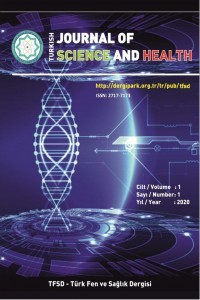Thyroid hormones as a potential prognostic markers for neonates with hypoxic ischemic encephalopathy
Thyroid hormones as a potential prognostic markers for neonates with hypoxic ischemic encephalopathy
Newborn, Hypoxic ischemic encephalopathy, Hypothermia, Thyroid hormones,
___
- &NA; 2014. “Neonatal Encephalopathy and Neurologic Outcome.” Postgraduate Obstetrics & Gynecology 34(18):6. doi: 10.1097/01.pgo.0000453617.48477.32.
- Das BK, Agarwal P, Agarwal JK, Mishra OP. n.d. “Serum Cortisol and Thyroid Hormone Levels in Neonates with Sepsis. Indian J Pediatr. 2002 Aug;69(8):663-5. Doi: 10.1007/BF02722699. PMID: 12356216.”
- Borges, Marietta, Roberto Lanes, Luis A. Moret, Diana Balochi, and Sacramento Gonzalez. 1985. “Effect of Asphyxia on Free Thyroid Hormone Levels in Full Term Newborns.” Pediatric Research 19(12):1305–7. doi: 10.1203/00006450-198512000-00020.
- Chimbo, Tania, Yesenia Castro, and Fabricio González-Andrade. 2019. “Non-Thyroid Disease Syndrome and Other Thyroid Function Anomalies in Ecuadorian Newborns with Early and Late Neonatal Sepsis.” SN Comprehensive Clinical Medicine 1(12):1073–79. doi: 10.1007/s42399-019-00182-2.
- Franklin, R., & O’Grady, C. 1985. “Neonatal Thyroid Function: Effects of Nonthyroidal Illness.” The Journal of Pediatrics 107(4), 599–602. doi:10.1016/s0022-3476(85)80031-7.
- Galton V. A. 1972. “Some Effects of Altitude on Thyroid Function.” Endocrinology 91(6):1393-1403. doi:10.1210/endo-91-6–1393.
- Ganesan K, Wadud K. n.d. “Euthyroid Sick Syndrome.” 2020 Nov 2. In: StatPearls [Internet]. Treasure Is.
- Hankins, Gary D. V., Sophia Koen, Alfredo F. Gei, Suzanne M. Lopez, James W. Van Hook, and Garland D. Anderson. 2002. “Neonatal Organ System Injury in Acute Birth Asphyxia Sufficient to Result in Neonatal Encephalopathy.” Obstetrics and Gynecology. doi: 10.1097/00006250-200205000-00004.
- Kobayashi, Akira, Touhei Usuda, Masaki Wada, Takayuki Kaneko, Kinuko Kojima, and Akihiko Saitoh. 2018. “Thyroid Function in Asphyxiated Newborns Who Received Hypothermia Therapy.” Pediatrics International 60(5):433–37. doi: 10.1111/ped.13534.
- Kurinczuk, Jennifer J., Melanie White-Koning, and Nadia Badawi. 2010. “Epidemiology of Neonatal Encephalopathy and Hypoxic-Ischaemic Encephalopathy.” Early Human Development 86(6):329–38. doi: 10.1016/j.earlhumdev.2010.05.010.
- Lang, Tara R., Tyler K. M. Hartman, Susan R. Hintz, and Christopher E. Colby. 2007. “Hypothermia for the Treatment of Neonatal Ischemic Encephalopathy: Is the Genie out of the Bottle?” American Journal of Perinatology 24(1):27–31. doi: 10.1055/s-2006-958157.
- Martinello, Kathryn, Anthony R. Hart, Sufin Yap, Subhabrata Mitra, and Nicola J. Robertson. 2017. “Management and Investigation of Neonatal Encephalopathy: 2017 Update.” Archives of Disease in Childhood: Fetal and Neonatal Edition 102(4):F346–58. doi: 10.1136/archdischild-2015-309639.
- Moshang T Jr, Chance KH, Kaplan MM, Utiger RD, TakahashiO. n.d. “Effects of Hypoxia on Thyroid Function Tests.” J Pediatr 1980;97: 602–4.
- Moura Neto, Arnaldo, and Denise Engelbrecht Zantut-Wittmann. 2016. “Abnormalities of Thyroid Hormone Metabolism during Systemic Illness: The Low T3 Syndrome in Different Clinical Settings.” International Journal of Endocrinology 2016. doi: 10.1155/2016/2157583.
- P., Sunil, Haricharan R., and Venugopala L. 2017. “Effect of Perinatal Asphyxia on Thyroid Stimulating Hormone and Thyroid Hormone Levels in a Rural Tertiary Care Center in Mandya District of Karnataka, India.” International Journal of Contemporary Pediatrics 4(1):78–82. doi: 10.18203/2349-3291.ijcp20164014.
- Paul DA, Mackley A, Yencha EM. n.d. “Thyroid Function in Term and Late Preterm Infants with Respiratory Distress in Relation to Severity of Illness. Thyroid. 2010 Feb;20(2):189-94. Doi: 10.1089/Thy.2009.0012. PMID: 20151826.”
- Pereira, D. N., and Renato S. Procianoy. 2003. “Effect of Perinatal Asphyxia on Thyroid-Stimulating Hormone and Thyroid Hormone Levels.” Acta Paediatrica, International Journal of Paediatrics 92(3):339–45. doi: 10.1080/08035250310009275.
- Perlman, Jeffrey M. 2006. “Intervention Strategies for Neonatal Hypoxic-Ischemic Cerebral Injury.” Clinical Therapeutics 28(9):1353–65. doi: 10.1016/j.clinthera.2006.09.005.
- S., Tan. 2021. “Available from URL: Https://Www.Uptodate.Com/Contents/Etiology-and-Pathogenesis-of-Neonatal-Encephalopathy. 2021.”
- Sarnat, Harvey B., and Margaret S. Sarnat. 1977. “Neonatal Encephalopathy Following Fetal Distress.” Obstetrical and Gynecological Survey 32(5):295–97. doi: 10.1097/00006254-197705000-00011.
- Shah, P., S. Riphagen, J. Beyene, and M. Perlman. 2004. “Multiorgan Dysfunction in Infants with Post-Asphyxial Hypoxic-Ischaemic Encephalopathy.” Archives of Disease in Childhood: Fetal and Neonatal Edition. doi: 10.1136/adc.2002.023093.
- Simonides, Warner S., Michelle A. Mulcahey, Everaldo M. Redout, Alice Muller, Marian J. Zuidwijk, Theo J. Visser, Frank W. J. S. Wassen, Alessandra Crescenzi, Wagner S. Da-Silva, John Harney, Felix B. Engel, Maria Jesús Obregon, P. Reed Larsen, Antonio C. Bianco, and Stephen A. Huang. 2008. “Hypoxia-Inducible Factor Induces Local Thyroid Hormone Inactivation during Hypoxic-Ischemic Disease in Rats.” Journal of Clinical Investigation. doi: 10.1172/JCI32824.
- Tahirovic HF. n.d. “Transient Hypothyroxinemia in Neonates Withbirth Asphyxia Delivered by Emergency Cesarean Section.” JPediatr Endocrinol 1994; 7: 39–41.
- Volpe, Joseph J. 2001. “Perinatal Brain Injury: From Pathogenesis to Neuroprotection.” Mental Retardation and Developmental Disabilities Research Reviews 7(1):56–64. doi: 10.1002/1098-2779(200102)7:1<56::AID-MRDD1008>3.0.CO;2-A.
- Wilson DM, Hopper AO, McDougall IR, Bayer MF, Hintz RL,Stevenson DK, et al. n.d. “Serum Free Thyroxine Values in Term,Premature, and Sick Infants.” J Pediatr 1982; 101: 113–7.
- Yalçın, Tuba, and Tanju Besler. 2016. “The Relationship Between the Thyroid Functions and Basal and Resting. Metabolic Rates ”. Journal of Nutrition and Dietetics 44(2):154–59.
- Başlangıç: 2020
- Yayıncı: Ümit Muhammet KOÇYİĞİT
AKADEMİSYENLERDE AŞI KARŞITLIĞININ DEĞERLENDİRİLMESİ
Fatma HASTAOĞLU, Sevda HASTAOĞLU ÖRGEN, Eylem Itır AYDEMİR
Funda EVCİLİ, Fatma TOK YILDIZ
Effect of Wheat Germ Oil on Wound Healing: An In Vitro Study in Fibroblast Cells
Muhammed GÖMEÇ, Gülnihal İPEK, Ayşegül ÖZTÜRK, Deniz ŞAHİN İNAN
Investigating the Relationship Between Cyberchondria Level and Perceived Stress in Young Adults
Filiz POLAT, Leyla DELİBAŞ, İbrahim BİLİR
Evaluation of Menstrual Irregularities and Dysmenorrhea in University Students
Çiğdem GÜN KAKAŞÇI, Dilek COŞKUNER POTUR
Özden BASKAN, Zeynep SOY, Muammer ÇORUM, Emre BASKAN
İlknur ENİNANÇ, Tuğba HERGÜNER
Burcu DEMİR GÖKMEN, Metin YILDIZ
Thyroid hormones as a potential prognostic markers for neonates with hypoxic ischemic encephalopathy
